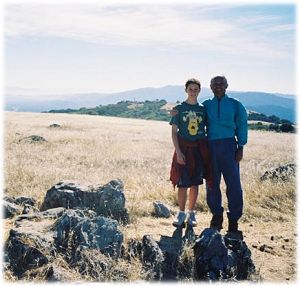Of the four routes requiring a climb of more than 2,000 feet, the one starting from the Rhus Ridge trailhead is the most popular. However, the parking area has room for only about eight cars, and on weekends finding a parking spot can be a challenge. To overcome this hurdle, Maia and I were there just after 7:30 A.M. On the plus side, however, was the fact that I had no doubt about Maia's hiking ability. Earlier this year, we had hiked some steep trails in Henry Coe State Park in 100-degree (F) weather. Last year, she had climbed White Mountain Peak, a 14,000 foot giant.
Maia has a very gregarious personality and I had no trouble carrying on a conversation with her. As a matter of fact, the only time we weren't talking was on the steepest sections of the trail. We discussed her participation in soccer, her stay last summer with a family in France and her aspiration to be an actress in theater. With her being only 12, boys were not a topic of discussion.

"What a terrible picture. Nobody can see my beautiful face."
"Sorry, Maia, but I like the picture; I am happy that they can't see my face."
We were at the top in two hours. After a little rest and a snack, we embarked on our next quest: looking for some geocaches. Geocaching is basically a hi-tech scavenger hunt. You need a computer with Web access, to log on to the web site that has the listing of geocaches, and a GPS receiver. A GPS receiver is a device that uses a system of orbiting satellites to determine its location, stated in latitude and longitude. The goal is to find locations where cache boxes are hidden. The caches usually contain just some inexpensive trinkets, but the thrill is in the searching and in the excitement of the find. The hobby has really taken off since its beginning in about April 2000. Currently, there are over 125,000 active caches worldwide. The majority are in the U.S., but even Antarctica has 12 caches.
The Fastest Way to Archive a Cache
This is a story about the day my cache shut the town down.
I hid a nice cache in a new local walking park. It was a tube full of small school supplies. I hid it on Sunday afternoon with my husband and ten-year-old daughter. On Monday morning, the first cacher came and found it. When placing the cache back in the stump, the cacher was spotted by a muggle, who called the police! The police thought it was a pipe bomb! They blocked off the roads! Evacuated the nearby homes! Called the Naval Weapons bomb squad! The bomb squad brought out their special robot, which x-rayed the cache and found "wire and undetermined other objects" (the wire was probably the wire from the spiral note pad).
The bomb "experts" still thought it was a bomb, so they blew it up! Oh yeah, the local press was there, too!
The police had the poor cacher's car plate number (that was a very observant muggle!). The cacher told me it was one find he'll never forget! It made the front page of the local Bedford, Indiana paper, the Times-Mail. I was glad the article left out my name as well as that of the other cacher. It explained how this was an internet game using GPS.
I have learned to label my hides "Geocache" from now on. The tube was wrapped in camouflage duct tape, but had no geocache label. I've never seen a pipe bomb, but I guess they look like the cache I'd hidden.
The Springville Park cache is now archived. It took me a while to see the humor of this situation. At work, I'm called the unibomber ... that's not so funny!
© 2004 Today's Cacher
Reprinted with permission.
Maia was delighted to find the three caches we went looking for. She had a young person's curiosity and examined each item in the cache very carefully. We signed the log-books and reluctantly headed back home, she to do some homework and I to do chores I had put off for the last eight days.
Dinesh Desai
October 2004